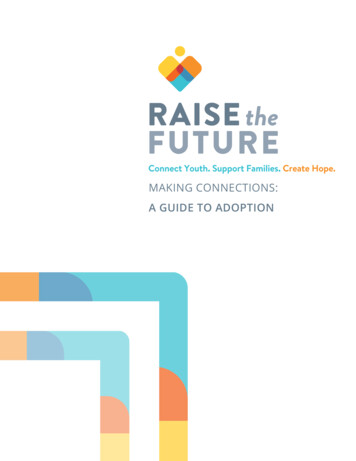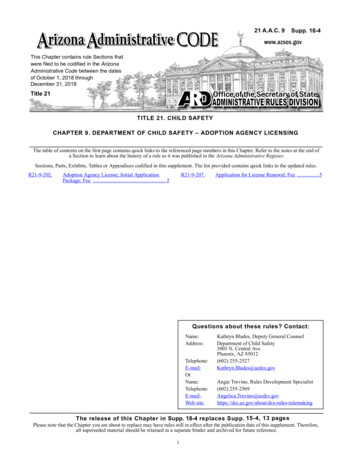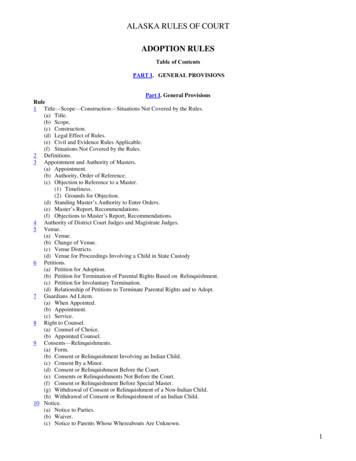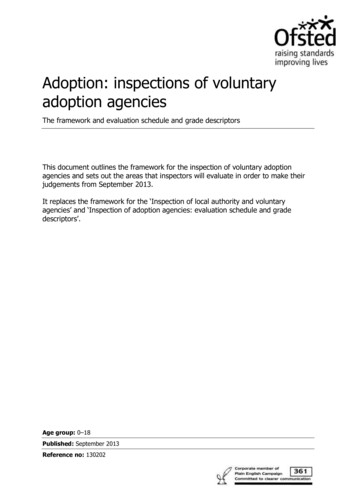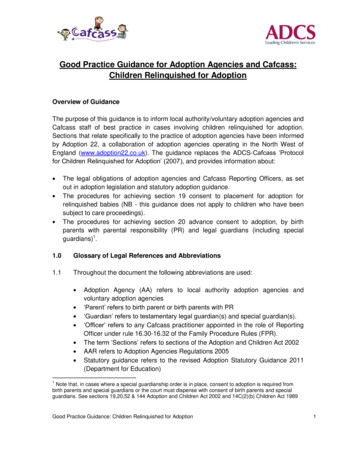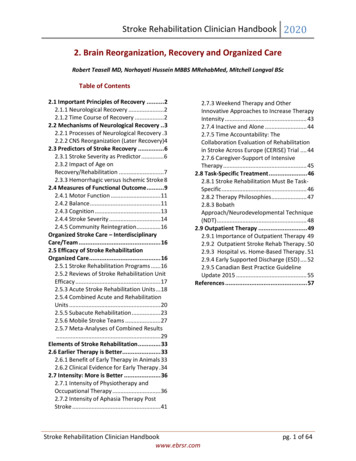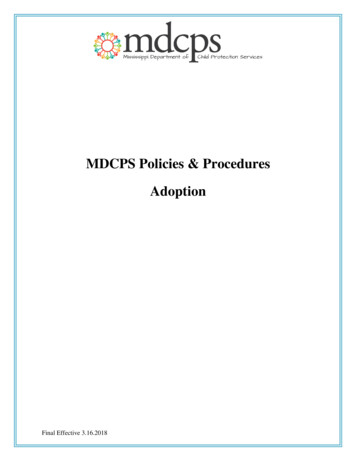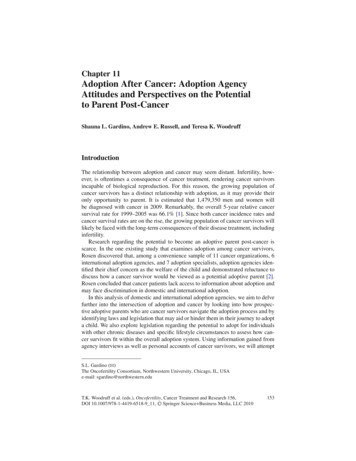
Transcription
Expediting Clinician Adoption of SafetyPractices: The UCSF Venous Access PatientSafety Interdisciplinary Education ProjectNancy E. Donaldson, Rosemary K. Plank, Ann Williamson,Jeffrey Pearl, Jerry Kellogg, Marcia RyderAbstractObjectives: The primary objective of the University of California, San Francisco(UCSF) Venous Access Device (VAD) Patient Safety Interdisciplinary EducationProject was to develop a 30-hour/one clinical academic unit VAD patient safetycourse with the aim of expediting clinician adoption of critical concepts related toVAD-related patient safety. This paper describes the evolution of theinterdisciplinary academic and continuing education courseware, and discussesthe theoretical and technological underpinnings of the work. Methods: Followingdevelopment of the academic course, the demand for derivative short versionswas identified by clinician users and administrators based on evidence of(1) patient safety threats, such as air embolism associated with central lineremoval; (2) VAD competency deficits; and (3) wide variation in learnercharacteristics and needs. Results: Consideration for differing learning needs andtime constraints of practicing clinicians led to the production of short versions ofthe core course, focusing on high-risk concepts related to VAD patient safety.Web-based courses using multiple media content presentation methodologies andaddressing learner preferences are expected to facilitate learning, retention andtransfer of the knowledge into practice. Conclusions: While the summativeproject evaluation is currently in progress, formative evaluation suggests thecourseware is highly linked to key patient safety concerns related to VADs andthat the core course, as well as the derivative short version of the content, may beinstitutionalized as a source of multidisciplinary clinical competencydevelopment, orientation, and training.IntroductionThe UCSF Interdisciplinary Venous Access Safety Education Project,launched in 2001, is grounded in the influential report of the Council on GraduateMedical Education and the National Nursing Council on Nurse Education andPractice, Collaborative Education to Ensure Patient Safety.1 Intended tosynthesize and package instructional courseware to expedite the interdisciplinarypractitioner transfer of critical patient safety concepts related to venous accessdevices (VADs) into practice, the development effort was undertaken within thecontext of contemporary health care delivery and professional practice. Severalkey factors influenced the demand for the program and informed the instructionaldevelopment process:283
Advances in Patient Safety: Vol. 4 Widespread restructuring of patient care delivery systems, evolvingover nearly 2 decades.2–9 Growth in America’s aging population and improved diseasemanagement in chronic illness populations, resulting in markedly morecomplex, severely ill hospitalized patient populations.2, 10 Consensus of consumers, policymakers, and the media that the healthcare system exposes patients to iatrogenic risks, errors, omissions, andcomplications that lead to unnecessary suffering and complications,prolonged recovery, extraordinary costs, and 44,000 to 98,000unnecessary deaths per year.3, 10–12 Association of VAD-related patient safety with nurse staffing and, inparticular, the use of float/agency/temporary staff. This associationhighlights the special challenges facing multidisciplinary staff, as theyattempt to form crucial collaborative relationships with temporarystaff.13–16 Primary use of peripheral and central line venous access devices(VADs) across the continuum of contemporary health care. More than25 million hospital patients across the United States receive peripheralintravenous catheters annually, and an estimated 7 million centralvenous catheters (CVCs) are inserted each year.17, 18The use of VADs spans all age groups from the preterm infant to the frailelderly and extends to almost any setting from the hospital to home, includingambulatory clinics, physicians’ offices, and long-term care facilities. While thesedevices are essential to medical management and the delivery of lifesavingtreatments, they are also a major contributor to morbidity and mortality, posing athreat to patient care quality, safety, and outcomes.The VAD threat to patient safetyOverall complication rates associated with VAD catheter placement have beenestimated at more than 10 percent.19 Catheter-related bloodstream infection(CRBSI) and thrombotic events are the major complications occurring in the postinsertion period of use. Approximately 10 percent of hospital-acquirednosocomial infections are bloodstream infections, of which 70 percent areattributed to the use of a VAD.20 As many as 350,000 patients acquire these lifethreatening infections each year,20 and it may be argued that VAD-relatedcomplications represent billions of dollars in health care expenditures and untoldsuffering for patients and their families.The insertion, care, and management of VADs across the continuum of careare multidisciplinary and interdisciplinary responsibilities. The safe use of VADsrequires training, supervision, and meticulous caution, or life-threateningcomplications can result.Hospital reorganization and restructuring efforts, in response to regulatory andmarketplace imperatives, have included redesigned inpatient care services284
Expediting Clinician Adoption of Safety Practices—UCSFresulting in reduced nurse-to-patient ratios, increased demands on direct carenurses related to the decentralization of ancillary services, and a loss of mediatingmiddle management and buffering clinical support services.21–24 Concurrently, asustained nursing shortage due to an aging workforce, low RN morale, reducedenrollments in basic and postbasic nursing programs, academic capacity, accesslimitations, and unprecedented employer demand threatens the ability of hospitalsto provide adequate nursing staff to ensure patient safety and quality care.25, 26Data suggest that there are unprecedented numbers of temporary nurses fillingvacant RN positions in acute care settings, further complicating the tradition ofhouse staff rotations and annual turnover in academic medical centers.Clinical workforce issues also add to the sense of VAD patient safety urgency,given the results of the Food and Drug Administration’s (FDA) seminal DeviceExperience Network survey. The findings suggest that 52–73 percent of reportedVAD complications have a cause-effect relationship associated with practitionertechnique.27 In response to these findings, the FDA convened the Central VenousCatheter Working Group (CVC–WG) to assess the problem and provide directionfor public health action.19 The primary goal of the group was to increase theawareness of VAD-associated complications and to educate practitioners in theappropriate use and management of these devices. The major effort of the groupwork was the development of an interdisciplinary educational video series,Central Venous Catheter Complications. Now is an opportune time to build onthis early VAD-related interdisciplinary education effort.Preventative strategies to minimize VAD complications have generallyfocused on technological advancement and interdisciplinary education andtraining. The Study of the Efficacy of Nosocomial Infection Control (SENIC),published in 1985, showed that both structure (expertise) and process(surveillance, feedback, and protocols) predicted lower infection rates.28 TheCenter for Disease Control’s (CDC) Guidelines for the Prevention of IntravenousDevice-Related Infections recommends systematic training repeatedly.29 Despitethe strength of these recommendations, however, a survey examiningorganizational policies regarding the insertion and care of CVCs indicated thatonly 56 percent of the acute care institutions surveyed conduct ongoing educationregarding VADs, while only 19 percent designate trained personnel for theinsertion and management of VADs.30 It has been suggested that adoption ofthese authoritative CDC recommendations may hinge on evidence demonstratingthe effectiveness of interdisciplinary education in preventing CRBSI andimproving patient outcomes.Cochran et al., examined the impact of an intravenous surveillance andeducation program (IVSP) on the reduction of CRBSI in a university teachinghospital.32 Nurse educators performed surveillance, developed hospitalprocedures, and conducted educational offerings related to VADs. The IVSPresulted in neither a reduction in the total CRBSI rate, nor a reduction in theproportion of potentially preventable CRBSI. The authors suggested that the costbenefits and patient outcomes associated with those VAD teams whose staff285
Advances in Patient Safety: Vol. 4directly perform VAD care, as distinct from staff that focus on surveillance andeducation of direct care staff, merit evaluation.Collaboration and institutionalization of multidisciplinary preventionstrategies may have a substantial effect on the rate of VAD complications. In aprospective cohort study, Eggimann et al31 implemented a multimodal,multidisciplinary prevention strategy designed to decrease the incidence ofIntensive Care Unit (ICU)-acquired CVC infections. Multiple changes inprotocols, together with an educational campaign, reduced infections from11.3 episodes to 3.8 episodes per 1,000 patient days.VAD education in academic health professions educationEvidence suggests that prelicensure nursing and medical education programsprovide little or no instruction on intravenous therapy, even though the care andmanagement of these devices are one of the most frequently required clinicalskills. A 1988 survey of U.S. college associate degree nursing programs indicatedthat 42 of 158 (27 percent) responding schools did not provide instruction invenipuncture skills.33 Moreover, post-licensure VAD procedure instruction forphysicians-in-training and graduate nurses is nonstandardized. The typicalgraduate nurse and physician have learned VAD clinical techniques and processesof care from clinical preceptors, thus their knowledge and competencies may varywidely.Conversely, there is compelling data to indicate that specialized educationlowers the risk of complications associated with VADs. Ely et al.34 conducted aninstitutional survey to determine physician and nursing awareness of CVCcomplication prevention and management. The survey detected a poor awarenessof venous air embolism (VAE) as a potentially fatal complication associated withCVCs. Awareness of VAE and its prevention did not correlate with the level ofphysician training or experience. The findings led to the creation of amultidisciplinary educational program specifically for incoming house officers.The program improved VAE awareness, but the authors noted that the effectdeclined rapidly. A more intensive and periodic hands-on educational programmay be needed—in addition to reinforcement through enhanced supervision ofCVC insertion and removal practices—to achieve a more sustained improvement.A review of the literature supports the notion that specialized training of allpersonnel involved with the insertion, care, and maintenance of vascular cathetersmay be one of the most important strategies for reducing VAD complications.35We argue, however, that education alone will not ensure VAD-related patientsafety. Optimal patient safety demands an organizational culture built around aprocess of care, focused collaboration, and institutionalized systems that supportand sustain VAD-related clinician competencies despite workforce turnover. Wefurther contend that VAD-related education may be most effective if it is alignedwith clinical role demands and relevant competencies. Only a few physicians mayinsert central lines, but more may remove them. The most effective learning alsomight be iterative, building systematically on prior learning and evolving clinicalexpertise, clinical settings, and patient populations.286
Expediting Clinician Adoption of Safety Practices—UCSFMethodsVenous access device patient safety: an overviewof the core course developmentIn developing the UCSF VAD Interdisciplinary Patient Safety EducationProgram, the universe of core concepts related to venous access device patientsafety was synthesized from the scientific literature, authoritative reports andguidelines, and expert opinions. It was further shaped by real-time clinical patientsafety issues that emerged from two large academic medical centers in California.A preliminary and comprehensive course blueprint was developed and reviewedextensively before undergoing further refinement through the use of feedbackfrom a multidisciplinary group of expert practitioners. The resulting content wasclustered into eight VAD Safety Core Course modules:1. VAD Safety—Overview2. Venous Access Anatomy and Physiology3. Selection of Venous Access Devices4. Insertion of VADs5. Care and Maintenance of VADs6. Diagnosing and Managing VAD Complications7. Improving VAD Patient Safety through Patient Education8. Continuous Quality Improvement—Strategies for Improving VAD PatientSafety Outcomes.The systematic instructional design process, guided by a seasonedinstructional technologist in the health sciences, was founded on several keyassumptions:1. The course would be evidence-based to the extent possible, and wouldintegrate expert opinion to resolve questions emerging from gaps in theevidence.2. The courseware would reflect an interdisciplinary approach, activelyengaging the interdisciplinary professional and adult learners to movethrough mediated learning activities with a clinical application focus and adidactic dialogue style.3. The course would be highly self-directed and Web-based; it wouldoptimize and individualize learner options and preferences; and it wouldrecognize wide variations in prior learning, experiences, and expertise.The courseware format was designed to be consistent between modules andincludes sections for learning objectives and learning plans. Learning plansections vary by topic, but always include primary course materials (i.e., links toanimated PowerPoint files), external sources for material other thanbibliographic references pertinent to module objectives, agency Web sites287
Advances in Patient Safety: Vol. 4involved in establishing guidelines for practice, assignments for independentinterdisciplinary practice/learning opportunities, and bibliographic reference listsfor traditional and online reference materials. Each module concludes with amultiple choice, self-assessment quiz. Originally, all educational materials wereplaced into PowerPoint and Word document files for posting in WebCT , thecontent management system (CMS) used by the University of California, SanFrancisco. An initial file functionality review led to a change in file formats, fromWord-based to HTML-based documents. Linkages and the user interface wereimproved. Constraints acknowledged by the VAD team included practitioner timelimitations, as well as those of the CMS, browser capabilities, users’ computersystem hardware and software limitations, Internet connection speeds, file types,and file sizes.The resulting VAD Safety Core Course is a 30-hour course and may requiremore time, based on learner pacing and Web-based education sophistication.While comprehensive, and perhaps even groundbreaking in its scope, feedbackfrom target multidisciplinary learners revealed that the ultimate effectiveness andutility of the VAD Safety Core Course was compromised by its length, conceptdensity, and expectation for student commitment. We also discovered that Webbased VAD education would need the capacity to animate and illustrate concepts,if we were to maximize learning.Linking instructional technology with an “evidence base”“What we are beginning to note most about e-learning is its growingdiversity, beyond courseware and instruction, to generating and disseminatinginformation and directly supporting performance.” — MJ Rosenberg 36Evidence-based practice integrates the explicit use of current best evidencewith clinical judgment, expertise, and patient preferences to make decisions aboutthe care of individual patients.37 Two influential Institute of Medicine reports, ToErr Is Human10 and Crossing the Quality Chasm,38 galvanized awareness amongthe health professions of the need to expedite the uptake of evidence to ensure thatclinical practices are aligned with science. In the face of exploding knowledgeand rapid cycle information dissemination, practitioners are challenged in theirquest to identify, synthesize, and interpret emerging new knowledge and thentranslate it systematically into practice. The American Academy of FamilyPhysicians, highlighting the potential contribution of technology, suggested thattraditional approaches to fostering the adoption of new knowledge need to bereplaced with new modes of practice-based learning and improvements thatinclude team performance, sharing of authority, nonpunitive critique, conflictresolution, and the use of new learning experiences for practice improvement.39The assumption that technology is a tool and strategy of evidence-based practice,and should be used to expedite positive outcomes for patients and for learners,served as a foundation for the UCSF VAD Interdisciplinary Education team’swork.288
Expediting Clinician Adoption of Safety Practices—UCSFLeveraging technology to optimizevenous access educationThe UCSF VAD Patient Safety Interdisciplinary Education WebCT 30-hourcore course was designed as an elective course for graduate students in the healthprofessions. It was offered initially to students and clinicians within the UCSFSchools of Nursing and Medicine, in the fall of 2002. Seminar sessions wereincluded in the first core course offering, to augment the basic online content withlecture and discussion while providing an opportunity for formative evaluation.When the core course was repeated the following academic quarter, the classroomseminar component was eliminated (though faculty contact was available to allstudents via e-mail), to better evaluate the prospect of offering the course entirelyonline.As course evaluations were analyzed and information about the course wasdisseminated in medical and nursing meetings and at interdisciplinary grouppresentations (which included attending physicians, quality professionals, andacademic/clinical administrators), feedback led the project team to reassess theneeds of target learners and patient safety stakeholders.40 The steps in thisassessment process included identification of (1) urgent VAD safety factorsidentified in guidelines established by subject matter experts, (2) distinctionsbetween VAD safety content that was “urgent” and that deemed “nice to know”by subject matter specialists, (3) the interplay between theoretical and appliedknowledge in VAD clinical applications, and (4) learning styles or strategiesspecific to each group that warranted project revision considerations. Withfeedback affirming the demand for versions of the course geared to postlicensureclinicians, the project team advanced the development of derivative educationalproducts that were distilled from the core course and strategically aligned withconsensually validated organizational and clinical priorities for VAD safetyimprovements, competencies, and outcomes.Web-based courseware developmentand learner characteristicsInformed by core course student evaluations, expert reviews, and stakeholderfeedback, it was clear to the VAD Interdisciplinary Patient Safety Education teamthat abbreviated, competency-driven versions of the 30-hour, all-inclusive VADcore course were needed, with an emphasis on high risk mortality/morbidityissues (e.g., prevention of air embolism during CVC removal). The effectivenessof the courseware was further enhanced by the addition of short graphicanimations with appropriate labeling and narrations depicting critical conceptsand processes involved in catheter placement and removal. The animations alsosimulated pathophysiological responses to complications associated with cathetermisplacement or misuse, visually reinforcing information from the text. Narratedstreaming video demonstrations of procedures affecting patient safety, such asVAD removal, also were added to appeal to differences in the learning styles andlearning preferences of the target groups.289
Advances in Patient Safety: Vol. 4Content specific to central venous catheter removal was developed usingfeedback from clinicians internal and external to UCSF. Physicians, house staff,and direct care and advanced practice nurses were regarded as the targetaudiences for this content, based on the consensus that these groups have thegreatest impact upon CVC patient safety during line removal.Discussion of key concepts and instructional dilemmas with clinicalpractitioners was ongoing throughout the developmental process. Literaturereviews related to learning styles and strategies, learning preferences, andcontinuing education needs supported the course evaluation feedback andcontributed to decisions regarding the module content and delivery. The goal ofthe clinician-focused instructional development process was to facilitate clinicianretention and the application of a defined body of knowledge (i.e., VAD patientsafety issues), while producing a behavioral change (i.e., improved VADpractices). This goal is congruent with the general view of self-directed orindependent learning—a common online instructional strategy41, 42—as well asevidence-based practice. Moreover, leveraged technology capitalizes on thecapacity of Web-based education to expedite revolutionary changes in clinicalbehaviors and practice, a goal highlighted in the recommendations of the Councilon Graduate Medical Education and the National Nursing Council on NurseEducation and Practice, in their 2000 report, Collaborative Education to EnsurePatient Safety.1Optimizing self-directed learning and continuing educationSelf-directed learning is defined as “a process in which individuals take theinitiative, with or without the help of others, in (1) diagnosing their learningneeds, (2) formulating learning goals, (3) identifying human and materialresources for learning, (4) choosing and implementing appropriate learningstrategies, and (5) evaluating learning outcomes.”43 Though self-directed learningis grounded in the principles of adult learning, the desire for self-directed learningis dependent upon population, educational experience, degree of learningmaturity, learning style, lived experience, and learner-based preferences.42–44 Thissuggests that self-directed learning should be viewed on a continuum, with oneend being teacher-directed learning, and the opposite end being entirely selfdirected learning. The realization that all learners fall somewhere along thiscontinuum posed potential difficulties, given the development of an onlineprogram (a method understood to be more self-directed than teacher directed).Recognition of these challenges, however, supported an instructional design thatincluded activities that might be construed as less self-directed and more moduledirected—with the module taking the place of the instructor. Our ongoingconsultation with medical school and medical staff colleagues affirmed a findingrepeated throughout the literature, suggesting that physicians, in general, desire toselect their own learning situations, while their approach to learning is influencedby the specificity of the identified problem.45–47Emphasis on self-directed learning is recommended increasingly in nursingand medical educational programs to foster continuing education during post290
Expediting Clinician Adoption of Safety Practices—UCSFgraduate clinical practice, to facilitate lifelong learning, and to maintain currencyin evidence-based health care.39, 41, 46–50 While continuing education for nurses hasbeen required for relicensure in California since 1971, and nationally since 1974,the amount of time practicing nurses spend on self-directed learning forprofessional reasons is small.42 Attitudes of medical students also vary in terms ofthe desire to participate in self-directed learning activities.42, 47 Slotnick noted thatlearning self-direction for physicians in clinical practice is influenced by theperception of the problem and learning decision stage. 47 Engaging in self-directedlearning often is linked to the content expertise of the supervising educator/mentor, the educator’s knowledge of how people learn, and the experienceslearners have had in prior learning situations.50–53When stakeholders in the University of California system advised that a CVCRemoval Module for house staff and clinicians would need to be limited to30 minutes of active learning time to achieve the goal of “institutionalizing” thecritical patient safety content, the operational definition of “short in duration” wasmade clear. Given the time constraints, facilitation of self-direction was a priority.Knowledge such as how people learn, how content needs to be prepared anddelivered for self-directed learning, the immediacy and scope of the VAD safetyproblem, and the acceptable duration for CME/CEU courses was taken intoconsideration throughout the instructional design and production process. Themodules were designed to engage learners in a didactic dialogue that encouragedthem to consider the application of the key concepts in their own practice role andsetting. In addition, each VAD core module has a prelearning knowledge selfassessment inventory and a posttest reflecting these same principles. Finally,activities and references were provided to stimulate further independent learningrelated to VAD safety, upon completion of the focused module.Learning style/learning preferencesAudience characteristics and preferences are not the only learner attributes towarrant consideration; individual learning styles also must be addressed in a welldeveloped program. Learning style is defined as an interconnection of cognitive,affective, and physiological characteristics that serve as relatively stableindicators of how a learner perceives, interacts with, and responds to the learningenvironment.54Although each learner perceives, interacts with, and responds to the learningenvironment in his or her own unique way, it has been suggested that a commonlearning style may exist among members of the same discipline/profession.54, 55On the other hand, research findings related to learning style similarities inprofessions have been mixed.40, 41, 44, 46, 47, 49, 53, 56 Two common factors cited inmultiple studies related to learning styles contend that (1) multiple learning stylesshould be addressed within any given learning event, and (2) individual learnersbenefit from knowing the differences between their own learning style and thoseof others.Multiple learning style inventories have been used in the literature to discusslearning styles. Kolb’s Learning Style Inventory (LSI)55, 56 has been recognized as291
Advances in Patient Safety: Vol. 4being psychometrically reliable and was used most frequently to evaluatemedicine and nursing learning styles. Given these two factors, learning stylecategories from the LSI were chosen for use in the VAD module development.Kolb identified four basic learning styles: convergent, divergent, assimilative,and accommodative. To address diversity of learning attributes, the VAD Safetycourseware used various content-delivery strategies. The converger thinksabstractly and desires to actively experiment. An activity using a patient scenariofor clinical problem-solving would stimulate active experimentation usingprocedural simulations that can be applied in the practice setting. Case studies orexamples that parallel clinical application or intervention appeal to abstractthinkers and active experimenters. The diverger (opposite of the converger) seeksconcrete experiences (e.g., field work, direct observation, or issue-specific mediafiles), and prefers reflective observation, (e.g., via diaries, logs, or brainstormingdiscussion groups). Using a case example to stimulate a peer discussion of thepositives and negatives of potential treatments or procedures would engage thediverger. The assimilator enjoys learning through abstract conceptualization andreflective observation, and likes to develop logical and precise theoretical models.An assignment observing multiple methods for performing the same procedure, asa means of developing a general model using the best of all the applicationversions, would be effective for the assimilator. The accommodator implementsplans and adapts to new situations using a combination of concrete experience andactive experimentation, rather than theoretical learning. The use of trial and errortechniques in problem solving is characteristic of the accommodator.41, 55, 56ResultsAlignment of online curriculum with learner attributesIn developing the derivative, clinician-focused versions of the VAD PatientSafety Core Course, the VAD Project Team responded to clinician demands forcontinuing education courseware designed to reduce air embolism threats topatients from improper VAD removal. During courseware development, attentionwas given to diverse learning styles, self-directedness, learning preferences andcontinuing education requirements for license renewal both in medicine andnursing.The table below presents a summary of the course components and links toevidence-based practice and learner attributes. Although the VADInterdisciplinary Education team has incorporated multiple content deliverymethods aimed at diverse learning styles, participant feedback remains vital sinceeach course/module potentially serves learners with different learning styles.Additional evaluation, now in progress, will guide future methods for deliveringcourse materials.292
Expediting Clinician Adoption of Safety Practices—UCSFTable 1. Cours
practitioner transfer of critical patient safety concepts related to venous access devices (VADs) into practice, the development effort was undertaken within the context of contemporary health care delivery and professional practice. Several key factors influenced the demand for the program and informed the instructional development process:
